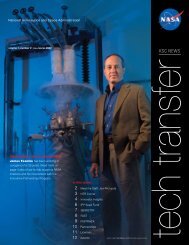2006-2007 - Kennedy Space Center Technology Transfer Office
2006-2007 - Kennedy Space Center Technology Transfer Office
2006-2007 - Kennedy Space Center Technology Transfer Office
- No tags were found...
You also want an ePaper? Increase the reach of your titles
YUMPU automatically turns print PDFs into web optimized ePapers that Google loves.
Composite Materials for Low-Temperature Applications<strong>2006</strong> <strong>Center</strong> Director’s Discretionary Fund ProjectComposite materials with improved thermal conductivity and good mechanicalstrengthproperties should allow for the design and construction of more thermallyPropellant Loading/Servicing/Storageefficient components (such as pipes and valves) for use in fluid-processing systems.These materials should have wide application in any number of systems, includingground support equipment (GSE), lunar systems, and flight hardware that need reduced heattransfer. Researchers from the Polymer Science and <strong>Technology</strong> Laboratory and the CryogenicsLaboratory at <strong>Kennedy</strong> <strong>Space</strong> <strong>Center</strong> were able to develop a new series of composite materialsthat can meet NASA’s needs for lightweight materials/composites for use in fluid systems and alsoexpand the plastic-additive markets. With respect to thermal conductivity and physical properties,these materials are excellent alternatives to prior composite materials and can be used in theaerospace, automotive, military, electronics, food-packaging, and textile markets. One specificapplication of the polymeric composition is for use in tanks, pipes, valves, structural supports,and components for hot or cold fluid-processing systems where heat flow through materials is aproblem to be avoided. These materials can also substitute for metals in cryogenic and other lowtemperatureapplications.These organic/inorganic polymeric composite materials were invented with significant reductionin heat transfer properties. Decreases of 20 to 50 percent in thermal conductivity versus that ofthe unmodified polymer matrix were measured. These novel composite materials also maintainmechanical properties of the unmodified polymer matrix.These composite materials consist of an inorganic additive combined with a thermoplasticpolymer material. The intrinsic, low thermal conductivity of the additive is imparted into thethermoplastic, resulting in a significant reduction in heat transfer over that of the base polymeritself, yet maintaining most of the polymer’s original properties. Normal polymer processingtechniques can turn these composite materials into unique, custom parts for ground support,Shuttle, and Constellation needs.We fabricated test specimens of the composite and base materials for thermal and mechanicalcharacterization and found that the strength of the composite material at nominal-percentageloading remained relatively unchanged from the base material. In some polymer materials, thecomposite was noticeably more flexible at lower and cryogenic temperatures. In all cases, the heattransfer of test articles was reduced compared to the parent polymer.Prototype GSE test articles were manufactured for use as seals and gaskets in cryogenic pipingapplications (see the figure). These articles are being evaluated on a proof-of-concept basis ascandidate replacement materials for current polymer materials found to crack upon repeatedthermal cycling. Additional testing will be required to raise the technology readiness level forcontinual GSE use. Future relevant environmental testing will prove the feasibility of compositematerials in space and commercial applications.By incorporating a hydrogen-sensing pigment, we developed and fabricated another compositetechnology. This composite can sense hydrogen at cryogenic temperatures and was demonstratedin a tape form on Launch Pad 39A in the Orbiter Midbody Umbilical Unit deployment forSTS-117, STS-118, STS-120, and STS-122.74 Fluid System Technologies













